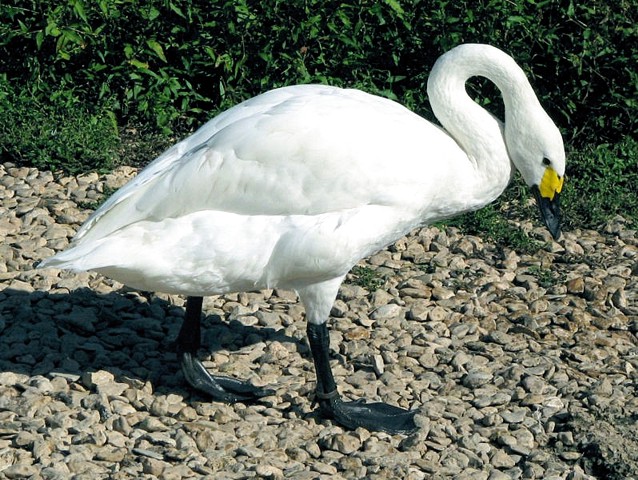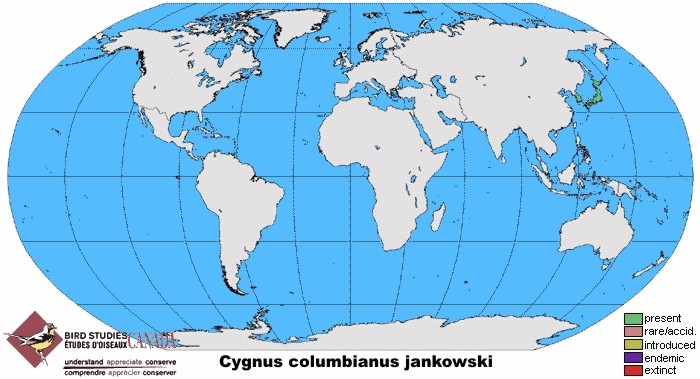Lessico
Cigno fischiatore
Cygnus columbianus
Scientific classification
Kingdom: Animalia
Phylum: Chordata
Class: Aves
Order: Anseriformes
Family: Anatidae
Genus: Cygnus
Species: Cygnus columbianus
Binomial name Cygnus columbianus (Ord, 1815)
Subspecies Cygnus columbianus bewickii - Cygnus columbianus columbianus
The Bewick's Swan or Tundra Swan (Cygnus columbianus) is a small Holarctic swan. This taxon is sometimes split into two species, Cygnus bewickii of the Palaearctic and the Whistling Swan Cygnus columbianus of the Nearctic, but the latest evidence suggests they should be considered as subspecies within Cygnus columbianus. Bewick's Swan is named after the engraver Thomas Bewick, who specialised in illustrations of birds and animals.



Cygnus columbianus bewickii
Bewick's is the smallest of the three Holarctic swans, at 115-146 cm (45-58 in) in length, a 170-195 cm (67-77 in) wingspan and a weight range of 4-9.5 kg (8.8-21 lbs). Cygnus columbianus bewickii is similar in appearance to the Whooper Swan, but is smaller, shorter-necked and has a more rounded head shape, with variable bill pattern, but always showing more black than yellow (the other way round with Whooper Swans). The bill pattern for every bird is unique, and scientists make detailed drawings of each and give them names to assist with studying this species. Cygnus columbianus columbianus is distinguished from Cygnus columbianus bewickii by its largely black bill with a small yellow spot of variable size at the base. Cygnus columbianus columbianus also averages larger than Cygnus columbianus bewickii. Cygnus columbianus columbianus is distinguished from the Trumpeter Swan of North America by that species' larger size and large bill, which is lined with salmon-pink along the mouthline instead of yellow on the lores.
Distribution





Bewick's Swans breed in the Arctic, Cygnus columbianus bewickii right across northern Russia from the Kola Peninsula east to the Pacific, Cygnus columbianus columbianus in Alaska and Canada. Cygnus columbianus bewickii migrates via the White Sea, Estonia, the Elbe estuary to winter in the Netherlands and the British Isles, especially in the wildfowl nature reserves of the Royal Society for the Protection of Birds and of the Wildfowl and Wetlands Trust. Populations breeding in eastern Russia (roughly east of the Taimyr Peninsula) winter in Japan and China; these are sometimes separated as the subspecies Cygnus columbianus jankowski, but this is not widely accepted as distinct, most authors including them in Cygnus columbianus bewickii. Cygnus columbianus columbianus winters in the coastal USA.
Behaviour
Their breeding habitat is Arctic. The female bird lays 4 to 7 eggs in a mound of plant material on a site near open water. The pair build the nest and defend a large territory around it. They pair for life, and their cygnets stay with them all winter; they are sometimes joined by offspring from previous years. In summer, their diet consists mainly of aquatic vegetation, eaten while swimming. At other times of year, they also eat cultivated grains in open fields. They have a high pitched honking call. According to National Geographic, when migrating these birds can fly at altitudes of nearly 27,000 ft.
Healthy adult birds have few natural predators. Although numbers are stable, they are increasingly dependent on agricultural crops to supplement their winter diet due to loss of aquatic vegetation in their winter habitat as a result of habitat destruction and water pollution.
The Bewick's Swan is one of the species to which the Agreement on the Conservation of African-Eurasian Migratory Waterbirds (AEWA) applies.

Cygnus columbianus columbianus